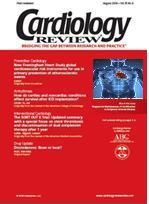Publication
Article
Cardiology Review® Online
The aging of stroke
Author(s):
Stroke is an especially important disease to study in terms of secular trends because it is so common, deadly, and disabling.
Stroke is an especially important disease to study in terms of secular trends because it is so common, deadly, and disabling. It has long held the position of the third leading cause of death and the leading cause of neurologic disability. It is largely a preventable disorder, with marked reductions in risk demonstrated in large and long-term studies with control of the vascular risk factors, in particular, hypertension, diabetes, elevated cholesterol, smoking, and atrial fibrillation.
Stroke is also predominantly a disease of the elderly. Approximately two thirds of strokes occur after age 65, and stroke risk increases in a geometric fashion with every decade thereafter.1 In the United States, this proportion of our population is shifting, from 12.4% in 1990 to a projected 16.3% by 2020.2 Therefore, it has become increasingly important to assess the effects of primary prevention efforts on trends in the occurrence and outcomes of stroke.
P
P
P
P
P
P
The study by Carandang and Wolf exhibits these trends admirably. This is a study using data from the Framingham Study, which involved 1030 incident strokes among its 10,333 participants over 3 epochs in a 54-year period, yielding 174,917 person-years of follow-up. The epochs correspond to pre-imaging (1950-1977), computed tomography (CT; 1978-1989), and magnetic resonance imaging (MRI; 1990-2004) eras. Their most important finding was a significant reduction in age-adjusted (the first period was referent) incidence of first stroke per 1000 person-years, from 7.6 to 5.3 in men and 6.2 to 5.1 in women across the 3 periods. This decrease was associated with concomitant decreases in mean systolic blood pressure (140 to 134 mm Hg in men; 145 to 131 mm Hg in women; < .001); current smoking (38% to 13% in men, < .001; 24 to 16 in women, < .001); and mean total cholesterol (231 to 199 mg/dL in men; 258 to 220 mg/dL in women; < .001). It was also associated with increases in mean body mass index in both sexes, from approximately 26 to 29 kg/m2 ( < .001), and increases in the percentage of diabetic participants, from 7% to 12% for men and 5% to 9% for women ( = .04). One can surmise that the effect of increase in these latter risk factors is overshadowed by the effect of decrease in the prevalence of other risk factors, particularly hypertension. In any case, it is noteworthy that in this cohort, reduction of vascular risk factors has not been uniform.
The second most important finding of the study was the change in mean age of the stroke sufferers, varying from 69 to 74 years in men and 69 to 81 years in women across the periods. This has particular significance when considering severity and 30-day mortality because of increased physical vulnerability and poorer social support systems in the elderly.3 Carandang and Wolf found decreases in severity and mortality with age adjustment for both men and women, although they were more pronounced and significant in men. They found this sex difference "intriguing," although the (much) older mean age of first stroke in women probably plays a role. Another consideration is the increasing influence of atrial fibrillation as a stroke risk factor in the elderly, which increases with age to as high as 11% in the ninth decade and is associated with greater stroke severity. 4 The authors note a decrease in the intermediate (ie, over 10 years) risk, but no decline in the lifetime risk of stroke at age 65 over the 3 periods. Stated another way, the incidence of stroke does not seem to be decreasing, only aging.
In recent years, the emphasis on stroke care has shifted to thrombolysis and new techniques in acute treatment, advanced diagnostic capabilities in CT and MRI, as well as more effective antithrombotic and other secondary preventive measures. But this study is important because it focuses on the too-often-forgotten issue of primary stroke prevention. It confirms encouraging reports that the incidence of stroke is decreasing, although it also discloses that the severity and lifetime risk of stroke are not. With the emergence of an older, more obese, and sedentary population, we are correct to be concerned that previous successes in population blood pressure control and smoking cessation will no longer be sufficient to minimize the effects of a highly lethal and disabling disease.






